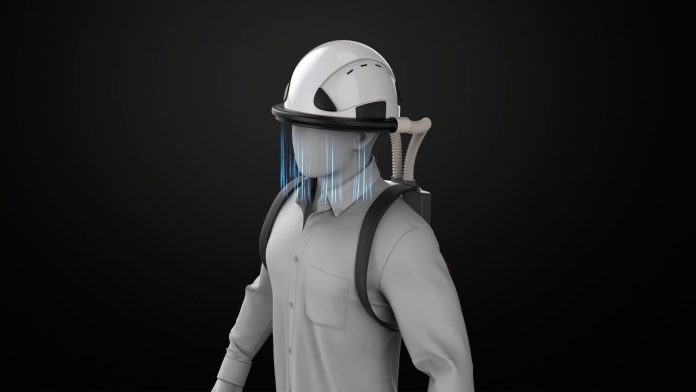
A groundbreaking invention by a University of Michigan startup, Taza Aya, has introduced a new way to protect workers from airborne viruses.
This technology, called a wearable air curtain, uses air treated to kill viruses, creating an invisible shield that blocks 99.8% of harmful aerosols from reaching a worker’s face.
This innovation is especially useful in industries where respiratory diseases are a concern.
The wearable air curtain is part of a hard hat and works by releasing a stream of air from nozzles around the hat’s brim.
Independent testing has confirmed that this air curtain effectively encircles the face, preventing harmful particles from reaching the wearer.
However, to ensure the air itself is safe, it must first be treated to remove and kill any pathogens.
Herek Clack, co-founder of Taza Aya and associate professor of civil and environmental engineering at the University of Michigan, explained how the air curtain works. “Our air curtain technology is designed to protect wearers from airborne infectious pathogens.
The treated air acts as a barrier, making any pathogens present inactive, so they can’t infect you if you breathe them in,” he said.
This level of protection is unique and also offers improved comfort for users.
The treatment process involves nonthermal plasma, which consists of highly energetic, electrically charged molecules. These molecules inactivate viruses and bacteria without using heat. The treated air then stabilizes into ordinary air before reaching the nozzles of the air curtain.
Taza Aya’s prototype includes a backpack weighing about 10 pounds. This backpack contains the nonthermal plasma module, an air handler, electronics, and a battery pack. The air handler draws in air, treats it in the module, and then sends it to the air curtain’s nozzles.
This innovation comes at a crucial time, following the COVID-19 pandemic and amid ongoing concerns about bird flu. During the pandemic, meat production was disrupted due to labor shortages, affecting prices and supply chains. Taza Aya’s device offers a new solution for protecting workers in agriculture and other industries.
User testing has been conducted with workers at Michigan Turkey Producers, a processing plant in Wyoming, Michigan. Many of these workers come into direct contact with turkeys and have faced challenges with traditional paper masks, which can muffle voices, hide facial expressions, and require a tight seal to be effective. These issues can hinder communication and safety.
Taza Aya’s wearable air curtain solves these problems. It provides protection without covering the mouth and nose, allowing for clearer communication and preventing fogging of safety goggles. The treated air is safe to breathe and keeps virus particles away from the worker’s face.
Herek Clack, originally a researcher focused on protecting livestock with nonthermal plasma, pivoted to using the technology for personal protection when COVID-19 emerged. Taza Aya was awarded in the Invisible Shield QuickFire Challenge, a competition by Johnson & Johnson Innovation and the U.S. Department of Health and Human Services. This competition aimed to develop technologies that protect against airborne viruses while minimally impacting daily life.
Alberto Elli, CEO of Taza Aya, expressed optimism about the technology’s future. “We are pleased with the study results as we embark on this journey. This real-world product and user testing experience will help us successfully launch the Worker Wearable in 2025,” he said.
This new wearable air curtain represents a significant advancement in protecting workers from airborne diseases, offering a safer and more comfortable alternative to traditional masks.
If you care about COVID, please read studies about vitamin D deficiency linked to severe COVID-19, death, and how diets could help manage post-COVID syndrome.
For more information about COVID, please see recent studies that low-sodium plant-based diets may prevent COVID-19 better, and results showing zinc could help reduce COVID-19 infection risk.



